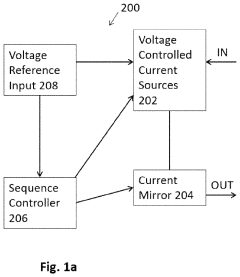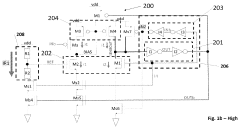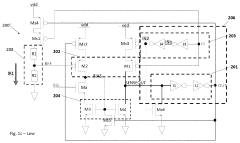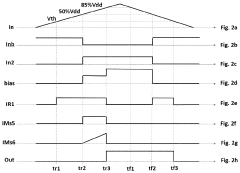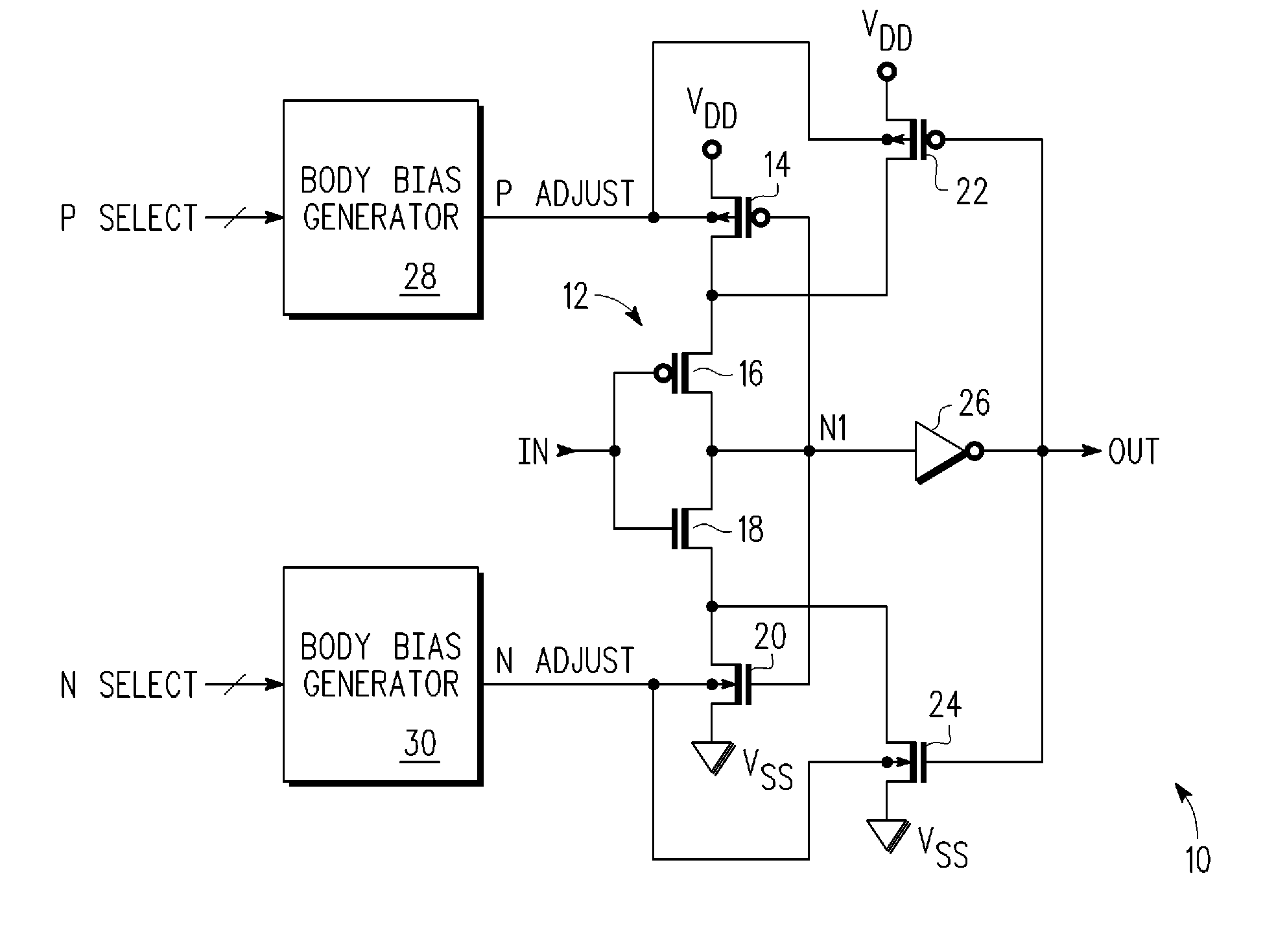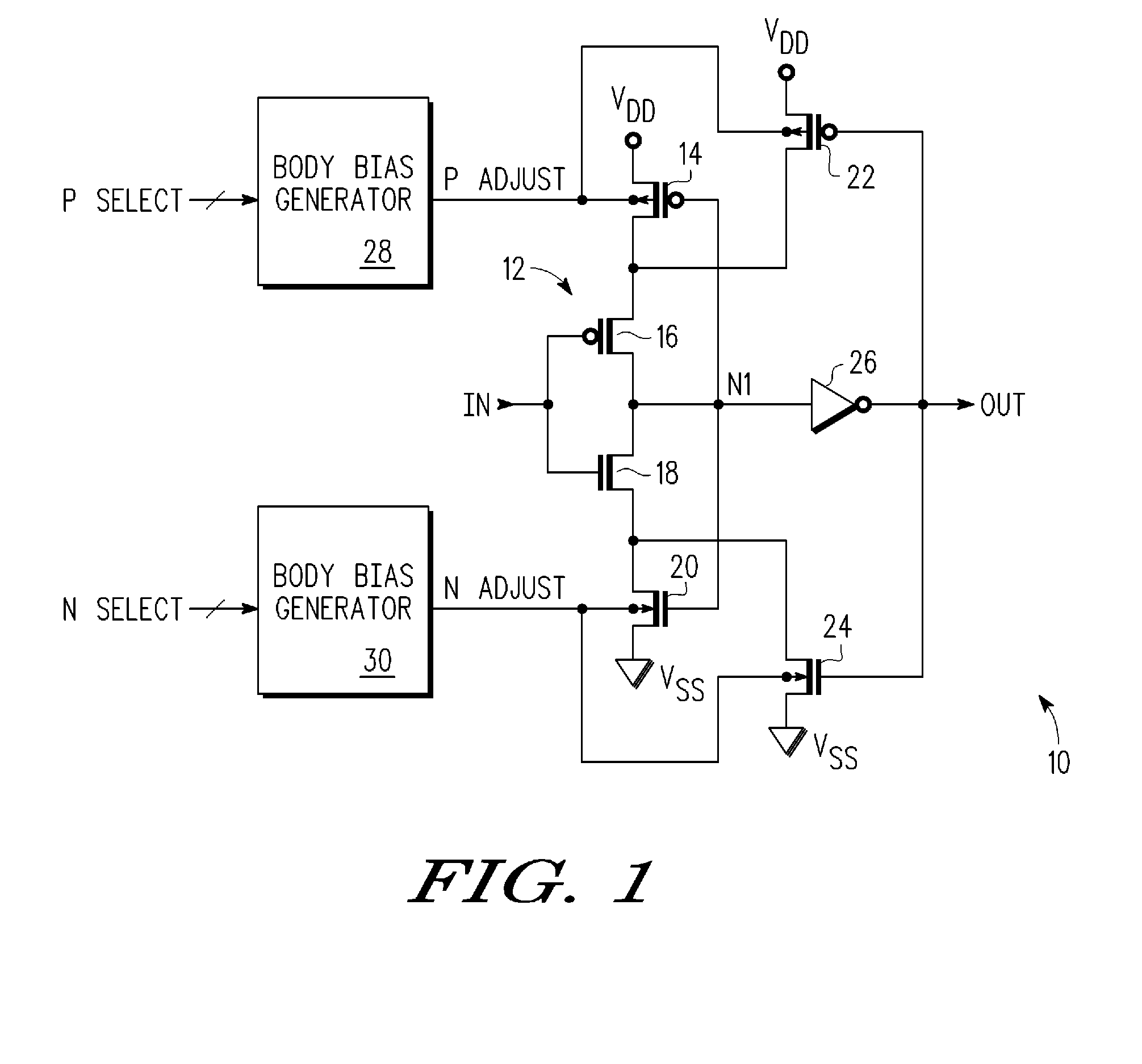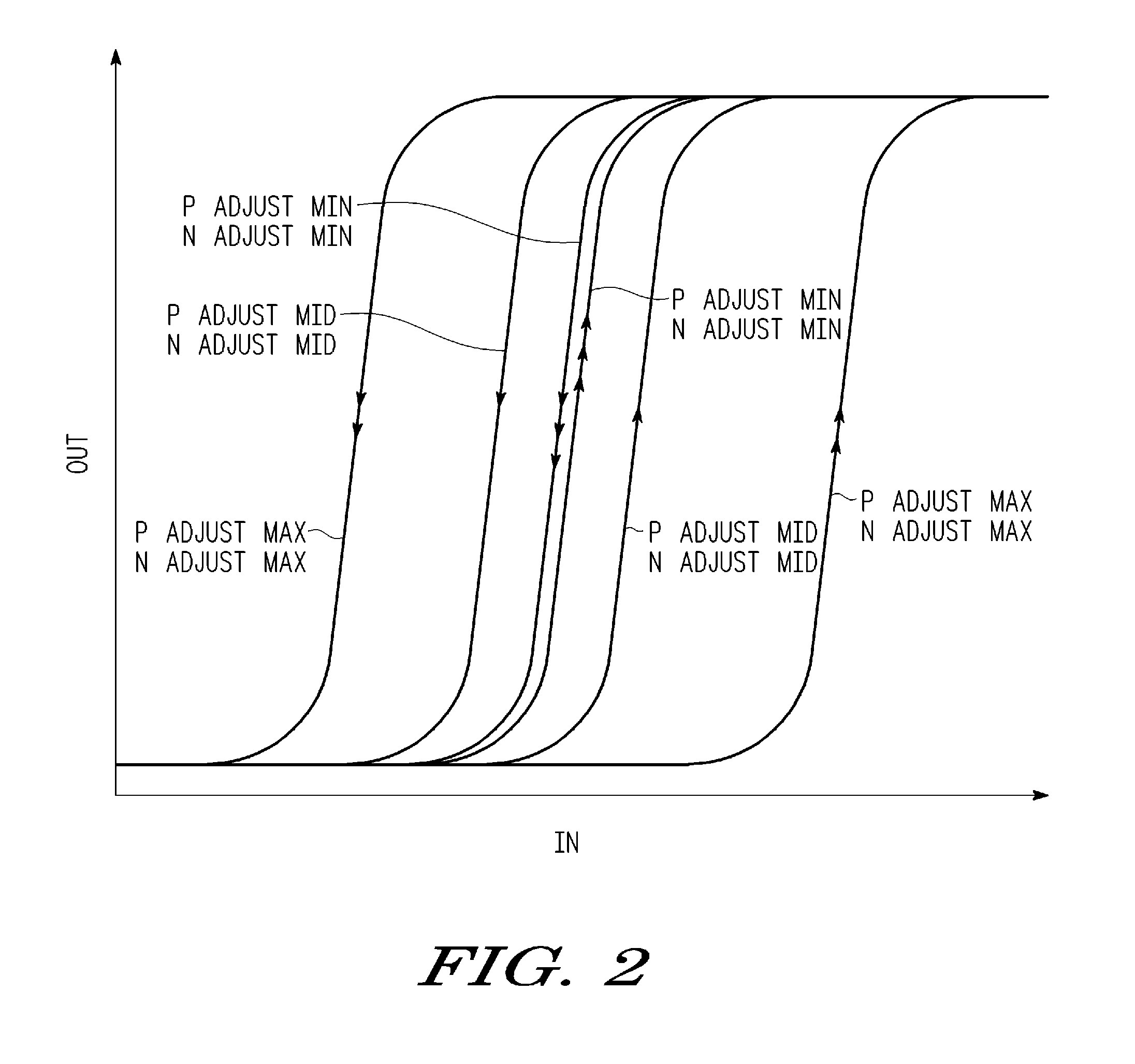Comparing Alternative Implementations of Schmitt Trigger Designs
SEP 23, 20259 MIN READ
Generate Your Research Report Instantly with AI Agent
Patsnap Eureka helps you evaluate technical feasibility & market potential.
Schmitt Trigger Evolution and Design Objectives
The Schmitt trigger, first introduced by Otto Schmitt in 1934, represents a fundamental circuit design that has evolved significantly over the decades. Initially conceived as a thermionic valve circuit for biological system studies, this comparator circuit with hysteresis has become an essential component in modern electronics, providing noise immunity and stability in signal processing applications.
The evolution of Schmitt trigger designs has been closely tied to broader semiconductor technology advancements. From vacuum tubes to discrete transistors in the 1950s and 1960s, then to integrated circuits in the 1970s, each technological shift has enabled new implementations with improved performance characteristics. The 1980s and 1990s saw the integration of Schmitt triggers into standard logic families like CMOS and TTL, while recent decades have focused on low-power, high-speed variants for portable and high-performance applications.
Current design objectives for Schmitt triggers center around several key parameters that must be optimized for specific applications. These include threshold voltage precision, hysteresis width control, switching speed, power consumption, noise immunity, and temperature stability. Modern applications increasingly demand Schmitt triggers that can operate at lower supply voltages while maintaining reliable performance across varying environmental conditions.
In digital systems, Schmitt triggers serve as input buffers that clean up slowly changing or noisy signals, preventing multiple triggering in logic circuits. For analog applications, they function as comparators with built-in positive feedback, providing stable transition points regardless of input signal noise. Industrial control systems utilize Schmitt triggers for sensor interfacing, where reliable threshold detection is critical despite environmental interference.
The miniaturization trend in electronics has pushed designers to develop Schmitt trigger implementations that occupy minimal silicon area while maintaining performance. This has led to innovative topologies that reduce component count and optimize layout. Additionally, there is growing interest in programmable Schmitt triggers whose hysteresis characteristics can be dynamically adjusted to suit changing operational requirements.
Emerging applications in IoT devices, wearable technology, and automotive systems have created new design objectives focused on ultra-low power consumption and operation across extreme temperature ranges. These applications often require Schmitt triggers that can function reliably with sub-1V supply voltages while consuming only nanowatts of power, presenting significant design challenges that continue to drive innovation in this mature yet evolving technology.
The evolution of Schmitt trigger designs has been closely tied to broader semiconductor technology advancements. From vacuum tubes to discrete transistors in the 1950s and 1960s, then to integrated circuits in the 1970s, each technological shift has enabled new implementations with improved performance characteristics. The 1980s and 1990s saw the integration of Schmitt triggers into standard logic families like CMOS and TTL, while recent decades have focused on low-power, high-speed variants for portable and high-performance applications.
Current design objectives for Schmitt triggers center around several key parameters that must be optimized for specific applications. These include threshold voltage precision, hysteresis width control, switching speed, power consumption, noise immunity, and temperature stability. Modern applications increasingly demand Schmitt triggers that can operate at lower supply voltages while maintaining reliable performance across varying environmental conditions.
In digital systems, Schmitt triggers serve as input buffers that clean up slowly changing or noisy signals, preventing multiple triggering in logic circuits. For analog applications, they function as comparators with built-in positive feedback, providing stable transition points regardless of input signal noise. Industrial control systems utilize Schmitt triggers for sensor interfacing, where reliable threshold detection is critical despite environmental interference.
The miniaturization trend in electronics has pushed designers to develop Schmitt trigger implementations that occupy minimal silicon area while maintaining performance. This has led to innovative topologies that reduce component count and optimize layout. Additionally, there is growing interest in programmable Schmitt triggers whose hysteresis characteristics can be dynamically adjusted to suit changing operational requirements.
Emerging applications in IoT devices, wearable technology, and automotive systems have created new design objectives focused on ultra-low power consumption and operation across extreme temperature ranges. These applications often require Schmitt triggers that can function reliably with sub-1V supply voltages while consuming only nanowatts of power, presenting significant design challenges that continue to drive innovation in this mature yet evolving technology.
Market Applications and Industry Demand Analysis
Schmitt triggers have established themselves as critical components across multiple industries due to their unique hysteresis characteristics that provide noise immunity in signal processing applications. The market demand for these components continues to grow steadily, driven primarily by the expanding electronics industry and the increasing need for reliable signal conditioning in noisy environments.
The automotive sector represents one of the largest markets for Schmitt trigger applications, with a significant demand increase observed over the past five years. These components are essential in engine control units, anti-lock braking systems, and various sensor interfaces where signal integrity is paramount despite electromagnetic interference. The transition to electric vehicles has further accelerated this demand, as power management systems require robust signal processing capabilities.
Industrial automation and control systems constitute another major application area, where Schmitt triggers are deployed in programmable logic controllers, motor drives, and factory automation equipment. The ongoing industrial digitalization trend, often referred to as Industry 4.0, has intensified the need for reliable signal conditioning components that can operate in electrically noisy factory environments.
Consumer electronics manufacturers represent a rapidly growing market segment, incorporating Schmitt triggers in smartphones, tablets, computers, and household appliances. The miniaturization trend in consumer devices has created specific demand for space-efficient Schmitt trigger implementations, particularly those with low power consumption characteristics.
Medical device manufacturers have also emerged as significant consumers of Schmitt trigger technology, utilizing these components in patient monitoring systems, diagnostic equipment, and therapeutic devices. The stringent reliability requirements in medical applications have driven demand for high-precision Schmitt trigger designs with exceptional stability across operating conditions.
Market analysis reveals regional variations in demand patterns. North America and Europe show strong demand for high-performance Schmitt triggers in specialized applications, while Asia-Pacific markets demonstrate volume-driven growth across consumer electronics manufacturing. The telecommunications sector globally continues to expand its utilization of Schmitt triggers in network infrastructure equipment.
The market is increasingly segmenting based on performance characteristics, with distinct demand profiles for high-speed, low-power, and high-reliability implementations. This segmentation has encouraged manufacturers to develop specialized Schmitt trigger designs optimized for specific application requirements rather than general-purpose solutions.
Forward-looking market indicators suggest continued growth in demand, particularly for Schmitt trigger implementations that can operate at lower voltages, consume minimal power, and maintain performance integrity across wider temperature ranges. The emerging Internet of Things ecosystem presents a significant opportunity, potentially becoming the largest application area within the next decade.
The automotive sector represents one of the largest markets for Schmitt trigger applications, with a significant demand increase observed over the past five years. These components are essential in engine control units, anti-lock braking systems, and various sensor interfaces where signal integrity is paramount despite electromagnetic interference. The transition to electric vehicles has further accelerated this demand, as power management systems require robust signal processing capabilities.
Industrial automation and control systems constitute another major application area, where Schmitt triggers are deployed in programmable logic controllers, motor drives, and factory automation equipment. The ongoing industrial digitalization trend, often referred to as Industry 4.0, has intensified the need for reliable signal conditioning components that can operate in electrically noisy factory environments.
Consumer electronics manufacturers represent a rapidly growing market segment, incorporating Schmitt triggers in smartphones, tablets, computers, and household appliances. The miniaturization trend in consumer devices has created specific demand for space-efficient Schmitt trigger implementations, particularly those with low power consumption characteristics.
Medical device manufacturers have also emerged as significant consumers of Schmitt trigger technology, utilizing these components in patient monitoring systems, diagnostic equipment, and therapeutic devices. The stringent reliability requirements in medical applications have driven demand for high-precision Schmitt trigger designs with exceptional stability across operating conditions.
Market analysis reveals regional variations in demand patterns. North America and Europe show strong demand for high-performance Schmitt triggers in specialized applications, while Asia-Pacific markets demonstrate volume-driven growth across consumer electronics manufacturing. The telecommunications sector globally continues to expand its utilization of Schmitt triggers in network infrastructure equipment.
The market is increasingly segmenting based on performance characteristics, with distinct demand profiles for high-speed, low-power, and high-reliability implementations. This segmentation has encouraged manufacturers to develop specialized Schmitt trigger designs optimized for specific application requirements rather than general-purpose solutions.
Forward-looking market indicators suggest continued growth in demand, particularly for Schmitt trigger implementations that can operate at lower voltages, consume minimal power, and maintain performance integrity across wider temperature ranges. The emerging Internet of Things ecosystem presents a significant opportunity, potentially becoming the largest application area within the next decade.
Current Implementations and Technical Limitations
Schmitt triggers are widely implemented across various electronic applications due to their unique hysteresis characteristics that provide noise immunity and clean signal transitions. Currently, several implementation approaches dominate the industry, each with distinct advantages and limitations.
The conventional CMOS implementation represents the most common approach, utilizing complementary MOS transistors to create the hysteresis effect. This implementation offers excellent power efficiency and integration capabilities within standard CMOS processes. However, it suffers from process variation sensitivity, which can lead to inconsistent threshold voltages across different manufacturing batches. Additionally, the hysteresis width is often difficult to precisely control in standard CMOS implementations.
Operational amplifier-based Schmitt triggers provide another popular implementation method. These designs leverage the high gain of op-amps to create sharp switching characteristics and allow for more precise control of threshold voltages through resistive feedback networks. The primary limitations include higher power consumption compared to CMOS implementations and increased circuit complexity. Furthermore, the frequency response is constrained by the op-amp's bandwidth, making them less suitable for high-frequency applications.
Discrete component implementations using BJTs (Bipolar Junction Transistors) offer robust performance in harsh environments and can handle higher voltages than typical CMOS designs. However, they consume significantly more power and occupy larger board space, making them impractical for modern integrated circuit applications where miniaturization is paramount.
Recent advancements have introduced current-mode Schmitt triggers, which demonstrate improved speed and reduced sensitivity to supply voltage variations. These implementations operate based on current comparison rather than voltage comparison, offering potential advantages in low-voltage applications. Their limitations include more complex design requirements and potentially higher static power consumption.
Programmable threshold Schmitt triggers represent an emerging category that allows dynamic adjustment of hysteresis levels. While offering unprecedented flexibility, these implementations face challenges in maintaining consistent performance across operating conditions and typically require additional control circuitry that increases overall complexity and power consumption.
A significant technical limitation across all implementations is the trade-off between speed and power consumption. Faster switching typically demands higher current capability, directly impacting energy efficiency. Additionally, temperature sensitivity remains a persistent challenge, with threshold voltages often exhibiting significant drift across operating temperature ranges, particularly in automotive and industrial applications where wide temperature ranges are common.
The conventional CMOS implementation represents the most common approach, utilizing complementary MOS transistors to create the hysteresis effect. This implementation offers excellent power efficiency and integration capabilities within standard CMOS processes. However, it suffers from process variation sensitivity, which can lead to inconsistent threshold voltages across different manufacturing batches. Additionally, the hysteresis width is often difficult to precisely control in standard CMOS implementations.
Operational amplifier-based Schmitt triggers provide another popular implementation method. These designs leverage the high gain of op-amps to create sharp switching characteristics and allow for more precise control of threshold voltages through resistive feedback networks. The primary limitations include higher power consumption compared to CMOS implementations and increased circuit complexity. Furthermore, the frequency response is constrained by the op-amp's bandwidth, making them less suitable for high-frequency applications.
Discrete component implementations using BJTs (Bipolar Junction Transistors) offer robust performance in harsh environments and can handle higher voltages than typical CMOS designs. However, they consume significantly more power and occupy larger board space, making them impractical for modern integrated circuit applications where miniaturization is paramount.
Recent advancements have introduced current-mode Schmitt triggers, which demonstrate improved speed and reduced sensitivity to supply voltage variations. These implementations operate based on current comparison rather than voltage comparison, offering potential advantages in low-voltage applications. Their limitations include more complex design requirements and potentially higher static power consumption.
Programmable threshold Schmitt triggers represent an emerging category that allows dynamic adjustment of hysteresis levels. While offering unprecedented flexibility, these implementations face challenges in maintaining consistent performance across operating conditions and typically require additional control circuitry that increases overall complexity and power consumption.
A significant technical limitation across all implementations is the trade-off between speed and power consumption. Faster switching typically demands higher current capability, directly impacting energy efficiency. Additionally, temperature sensitivity remains a persistent challenge, with threshold voltages often exhibiting significant drift across operating temperature ranges, particularly in automotive and industrial applications where wide temperature ranges are common.
Alternative Schmitt Trigger Implementation Approaches
01 CMOS-based Schmitt Trigger Implementations
Various CMOS-based implementations of Schmitt triggers that offer advantages such as low power consumption, high noise immunity, and compatibility with standard CMOS processes. These designs typically use complementary PMOS and NMOS transistors to create the hysteresis effect characteristic of Schmitt triggers, with modifications to improve performance metrics like switching speed, power consumption, and threshold voltage control.- CMOS-based Schmitt Trigger Implementations: CMOS technology offers various implementations of Schmitt triggers that provide improved noise immunity and switching characteristics. These designs typically use complementary PMOS and NMOS transistors to create hysteresis in the switching threshold. CMOS-based Schmitt triggers can be optimized for low power consumption, high speed operation, or reduced silicon area depending on the application requirements. These implementations often feature adjustable hysteresis levels and can operate across a wide range of supply voltages.
- Differential and Operational Amplifier-based Schmitt Triggers: Schmitt triggers can be implemented using differential amplifier or operational amplifier configurations. These designs leverage the high gain of amplifier circuits to create sharp switching transitions with well-defined hysteresis. The differential approach offers improved common-mode noise rejection and can be particularly useful in applications with noisy environments. By adjusting feedback resistor ratios, the hysteresis window can be precisely controlled. These implementations are often used in precision sensing and instrumentation applications.
- Low-power and Energy-efficient Schmitt Trigger Designs: Special Schmitt trigger designs focus on minimizing power consumption for battery-powered and energy-sensitive applications. These implementations employ techniques such as dynamic biasing, power gating, and subthreshold operation to reduce current draw while maintaining necessary hysteresis characteristics. Some designs incorporate adaptive threshold control that adjusts the circuit behavior based on operating conditions. These energy-efficient variants are particularly valuable in IoT devices, wearable electronics, and other applications where power constraints are critical.
- Discrete Component and BJT-based Schmitt Triggers: Traditional Schmitt trigger implementations using discrete components and bipolar junction transistors (BJTs) offer robust performance in various applications. These circuits typically use positive feedback through resistor networks to create hysteresis. BJT-based designs can provide high current drive capability and operate at higher voltages compared to some integrated alternatives. These implementations are often used in industrial control systems, power management circuits, and legacy applications where proven reliability is essential.
- Application-specific and Specialized Schmitt Trigger Circuits: Specialized Schmitt trigger designs address specific application requirements such as high-speed operation, ultra-wide hysteresis ranges, or integration with other circuit functions. These implementations may incorporate novel topologies or combine Schmitt trigger functionality with additional features like level shifting, frequency discrimination, or programmable thresholds. Some designs are optimized for particular signal types or environmental conditions. These specialized variants find use in applications ranging from high-frequency communications to automotive systems and industrial sensors.
02 Differential and Comparator-based Schmitt Triggers
Schmitt trigger implementations based on differential amplifiers or comparator circuits that provide improved noise immunity and precise threshold control. These designs often feature differential inputs and outputs, allowing for better common-mode rejection and more stable operation in noisy environments. Some implementations incorporate feedback mechanisms to create the hysteresis effect while maintaining high-speed operation.Expand Specific Solutions03 Low-voltage and Low-power Schmitt Trigger Designs
Specialized Schmitt trigger implementations optimized for low-voltage and low-power applications, particularly useful in battery-powered devices and energy-efficient systems. These designs employ various techniques such as body biasing, subthreshold operation, and innovative circuit topologies to maintain reliable hysteresis characteristics while minimizing power consumption and enabling operation at reduced supply voltages.Expand Specific Solutions04 Programmable and Adjustable Hysteresis Schmitt Triggers
Schmitt trigger implementations featuring programmable or adjustable hysteresis thresholds, allowing for dynamic adaptation to different operating conditions or application requirements. These designs incorporate control inputs or programmable elements that can modify the switching thresholds, enabling optimization for specific noise environments or signal characteristics without requiring circuit redesign.Expand Specific Solutions05 Bipolar and Mixed-technology Schmitt Trigger Circuits
Schmitt trigger implementations using bipolar transistors or mixed-technology approaches that combine elements of bipolar, CMOS, or other semiconductor technologies. These designs often leverage the inherent characteristics of bipolar transistors, such as high transconductance and good matching properties, to achieve superior performance in terms of speed, precision, or noise immunity compared to pure CMOS implementations.Expand Specific Solutions
Leading Manufacturers and Competitive Landscape
The Schmitt trigger design market is currently in a mature growth phase, characterized by established technologies and steady innovation. The global market for Schmitt trigger implementations is estimated at approximately $1.2 billion, driven by increasing demand in automotive electronics, industrial automation, and consumer devices. Leading semiconductor manufacturers like Texas Instruments, STMicroelectronics, and Infineon Technologies dominate with mature product offerings, while MediaTek and NXP provide specialized solutions. Companies such as SG Micro Corp and Skyworks Solutions are focusing on niche applications with innovative designs. The technology has reached high maturity with standardized implementations, though research continues at institutions like Xidian University and Case Western Reserve University to develop lower power consumption variants and integration with advanced semiconductor processes.
STMicroelectronics International NV
Technical Solution: STMicroelectronics has pioneered several innovative Schmitt trigger implementations, particularly in their ultra-low-power microcontroller and analog product lines. Their BCD (Bipolar-CMOS-DMOS) technology platform enables unique Schmitt trigger designs that combine the advantages of multiple process technologies. ST's approach features programmable hysteresis circuits that can be dynamically adjusted through digital control interfaces, allowing software-configurable noise immunity levels. Their latest designs incorporate sub-1V operation capability while maintaining hysteresis ratios of up to 30% of VDD. ST has developed specialized radiation-hardened Schmitt trigger variants for aerospace applications, featuring triple-redundant voting circuits and SEU (Single Event Upset) immunity up to 60 MeV·cm²/mg. Their automotive-qualified Schmitt triggers implement proprietary temperature compensation techniques that maintain consistent threshold voltages (±2% variation) across the full automotive temperature range.
Strengths: Excellent power efficiency (as low as 100nA per trigger); programmable hysteresis levels; superior radiation hardness for specialized applications. Weaknesses: More complex integration requirements for programmable variants; slightly higher unit cost compared to fixed-threshold alternatives.
Texas Instruments Incorporated
Technical Solution: Texas Instruments has developed multiple innovative Schmitt trigger implementations, including their advanced CMOS-based designs that feature hysteresis control circuitry. Their approach incorporates precision threshold voltage control through carefully designed feedback networks that maintain consistent switching characteristics across temperature variations. TI's Schmitt trigger designs are often integrated into their microcontroller and logic families, featuring propagation delays as low as 3.3ns and hysteresis windows that can be precisely tailored between 0.2V to 1.2V depending on application requirements. Their SN74LVC series implements Schmitt triggers with rail-to-rail operation capabilities and enhanced noise immunity, particularly valuable in industrial environments. TI has also pioneered low-power Schmitt trigger variants that operate efficiently at supply voltages as low as 1.65V while maintaining robust noise margins.
Strengths: Exceptional noise immunity in harsh industrial environments; wide operating voltage range (1.65V to 5.5V); precise hysteresis control for reliable switching. Weaknesses: Higher power consumption compared to some competitors' ultra-low-power designs; slightly larger silicon footprint in certain implementations.
Key Patents and Technical Innovations Analysis
Schmitt trigger voltage comparator
PatentActiveUS11190171B2
Innovation
- A Schmitt trigger voltage comparator circuit with a voltage reference input, current sources, a current mirror, and a sequence controller that enables zero DC current consumption by using voltage-controlled current sources and switches to control the current mirror, allowing for variable threshold voltages and precise operation across a wide range of supply voltages.
Schmitt trigger having variable hysteresis and method therefor
PatentInactiveUS20090237135A1
Innovation
- A Schmitt trigger with a variable hysteresis window is achieved by adjusting the threshold voltage of hysteresis-producing transistors through selective body bias voltage control, allowing for precise adjustment in response to manufacturing variations and temperature changes.
Performance Benchmarking Methodologies
Effective performance benchmarking is crucial when evaluating different Schmitt trigger designs. The methodology must encompass both quantitative measurements and qualitative assessments to provide comprehensive insights into the relative merits of alternative implementations. Standard benchmarking parameters include hysteresis width, switching thresholds, propagation delay, power consumption, noise immunity, and temperature stability.
Measurement setups should be standardized across all tested designs to ensure fair comparison. This typically involves using precision voltage sources for input signals, high-resolution oscilloscopes for timing measurements, and temperature-controlled environments for thermal performance evaluation. When benchmarking CMOS implementations against bipolar designs, for instance, the test conditions must account for their inherent differences in operating characteristics.
Statistical analysis forms an essential component of robust benchmarking methodologies. Multiple samples of each design should be tested to account for manufacturing variations, with results presented using statistical measures such as mean values, standard deviations, and confidence intervals. This approach provides more reliable insights than single-point measurements, particularly when evaluating designs intended for mass production.
Simulation-based benchmarking complements physical testing by allowing rapid evaluation across a wider range of operating conditions. SPICE models with accurate device parameters enable detailed analysis of circuit behavior under various scenarios. However, simulation results must be validated against physical measurements to ensure their reliability, as model inaccuracies can lead to misleading conclusions.
Application-specific benchmarking is particularly valuable when comparing Schmitt trigger designs for targeted use cases. For instance, automotive applications may prioritize temperature stability and noise immunity, while battery-powered devices might emphasize power efficiency. Tailoring the benchmarking methodology to reflect the intended application ensures that the evaluation criteria align with practical requirements.
Documentation of benchmarking methodologies is equally important as the results themselves. Detailed records of test conditions, equipment specifications, measurement procedures, and data processing techniques enable reproducibility and facilitate meaningful comparison between studies conducted by different researchers or organizations. This transparency builds confidence in the validity of performance claims and supports informed decision-making when selecting among alternative Schmitt trigger implementations.
Measurement setups should be standardized across all tested designs to ensure fair comparison. This typically involves using precision voltage sources for input signals, high-resolution oscilloscopes for timing measurements, and temperature-controlled environments for thermal performance evaluation. When benchmarking CMOS implementations against bipolar designs, for instance, the test conditions must account for their inherent differences in operating characteristics.
Statistical analysis forms an essential component of robust benchmarking methodologies. Multiple samples of each design should be tested to account for manufacturing variations, with results presented using statistical measures such as mean values, standard deviations, and confidence intervals. This approach provides more reliable insights than single-point measurements, particularly when evaluating designs intended for mass production.
Simulation-based benchmarking complements physical testing by allowing rapid evaluation across a wider range of operating conditions. SPICE models with accurate device parameters enable detailed analysis of circuit behavior under various scenarios. However, simulation results must be validated against physical measurements to ensure their reliability, as model inaccuracies can lead to misleading conclusions.
Application-specific benchmarking is particularly valuable when comparing Schmitt trigger designs for targeted use cases. For instance, automotive applications may prioritize temperature stability and noise immunity, while battery-powered devices might emphasize power efficiency. Tailoring the benchmarking methodology to reflect the intended application ensures that the evaluation criteria align with practical requirements.
Documentation of benchmarking methodologies is equally important as the results themselves. Detailed records of test conditions, equipment specifications, measurement procedures, and data processing techniques enable reproducibility and facilitate meaningful comparison between studies conducted by different researchers or organizations. This transparency builds confidence in the validity of performance claims and supports informed decision-making when selecting among alternative Schmitt trigger implementations.
Power Efficiency and Noise Immunity Considerations
Power efficiency and noise immunity represent critical performance metrics in Schmitt trigger design evaluation. When comparing alternative implementations, CMOS-based Schmitt triggers typically demonstrate superior power efficiency compared to bipolar junction transistor (BJT) designs, with static power consumption in the nanowatt range versus microwatts for BJT implementations. This advantage becomes particularly significant in battery-powered applications and IoT devices where energy conservation directly impacts operational longevity.
The power-noise immunity trade-off manifests differently across various Schmitt trigger architectures. Conventional designs achieve noise immunity through hysteresis, which requires additional current paths that increase power consumption. Recent innovations have introduced adaptive biasing techniques that dynamically adjust current consumption based on input signal characteristics, achieving up to 40% power reduction while maintaining comparable noise immunity levels.
Noise immunity performance varies significantly between implementations. Differential Schmitt trigger designs demonstrate superior common-mode noise rejection, typically 15-20dB better than single-ended configurations. However, this comes at the cost of increased transistor count and power consumption. Complementary CMOS implementations offer balanced noise immunity for both positive and negative transitions, while asymmetric designs may prioritize noise immunity in one transition direction at the expense of the other.
Temperature sensitivity further complicates the power-noise relationship. BJT-based Schmitt triggers exhibit pronounced threshold voltage drift with temperature variations (approximately -2mV/°C), necessitating additional compensation circuitry that increases power consumption. CMOS implementations demonstrate better thermal stability but require careful sizing to maintain consistent hysteresis across temperature ranges.
Supply voltage variation presents another critical consideration. Low-voltage Schmitt trigger designs (sub-1V operation) achieve remarkable power efficiency but often sacrifice noise immunity margins. Specialized rail-to-rail implementations maintain noise immunity across wide supply ranges but typically consume 15-30% more power than their standard counterparts.
Modern process technologies have enabled novel hybrid approaches combining the strengths of different implementations. For instance, subthreshold-biased Schmitt triggers achieve ultra-low power consumption (sub-100nW) while maintaining acceptable noise immunity through careful transistor sizing and body biasing techniques. These designs represent promising solutions for energy-harvesting applications where power constraints are extreme.
The power-noise immunity trade-off manifests differently across various Schmitt trigger architectures. Conventional designs achieve noise immunity through hysteresis, which requires additional current paths that increase power consumption. Recent innovations have introduced adaptive biasing techniques that dynamically adjust current consumption based on input signal characteristics, achieving up to 40% power reduction while maintaining comparable noise immunity levels.
Noise immunity performance varies significantly between implementations. Differential Schmitt trigger designs demonstrate superior common-mode noise rejection, typically 15-20dB better than single-ended configurations. However, this comes at the cost of increased transistor count and power consumption. Complementary CMOS implementations offer balanced noise immunity for both positive and negative transitions, while asymmetric designs may prioritize noise immunity in one transition direction at the expense of the other.
Temperature sensitivity further complicates the power-noise relationship. BJT-based Schmitt triggers exhibit pronounced threshold voltage drift with temperature variations (approximately -2mV/°C), necessitating additional compensation circuitry that increases power consumption. CMOS implementations demonstrate better thermal stability but require careful sizing to maintain consistent hysteresis across temperature ranges.
Supply voltage variation presents another critical consideration. Low-voltage Schmitt trigger designs (sub-1V operation) achieve remarkable power efficiency but often sacrifice noise immunity margins. Specialized rail-to-rail implementations maintain noise immunity across wide supply ranges but typically consume 15-30% more power than their standard counterparts.
Modern process technologies have enabled novel hybrid approaches combining the strengths of different implementations. For instance, subthreshold-biased Schmitt triggers achieve ultra-low power consumption (sub-100nW) while maintaining acceptable noise immunity through careful transistor sizing and body biasing techniques. These designs represent promising solutions for energy-harvesting applications where power constraints are extreme.
Unlock deeper insights with Patsnap Eureka Quick Research — get a full tech report to explore trends and direct your research. Try now!
Generate Your Research Report Instantly with AI Agent
Supercharge your innovation with Patsnap Eureka AI Agent Platform!
